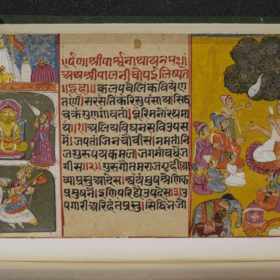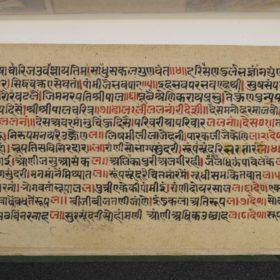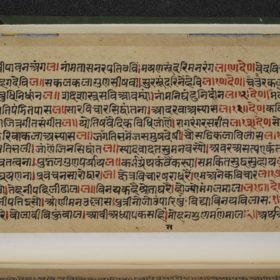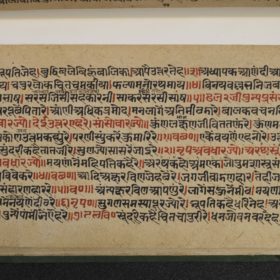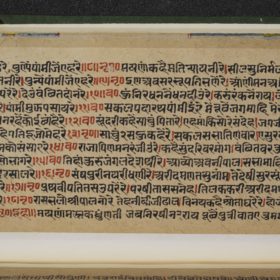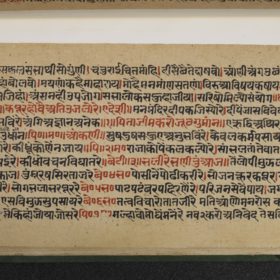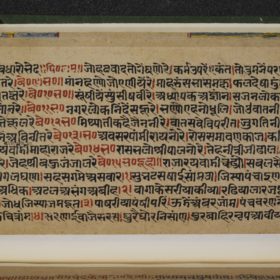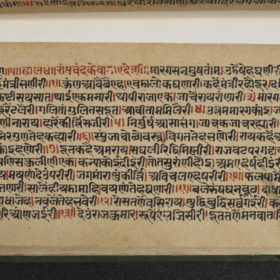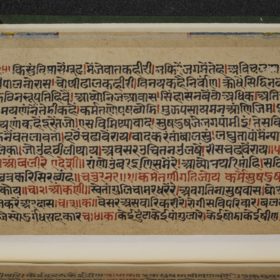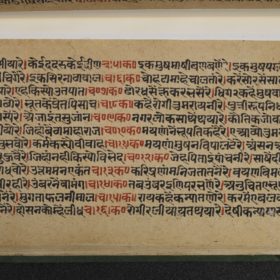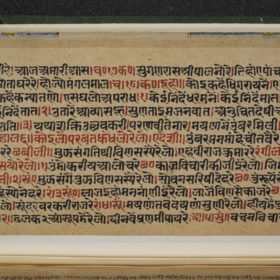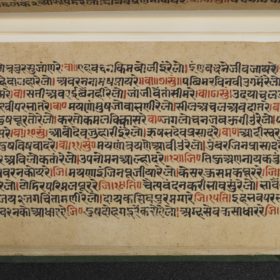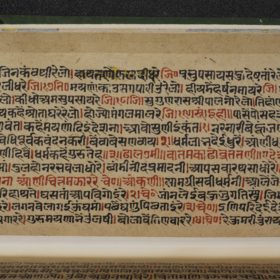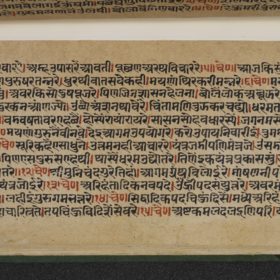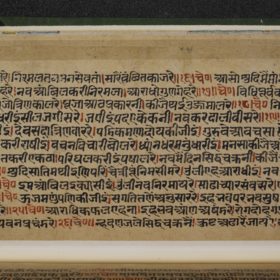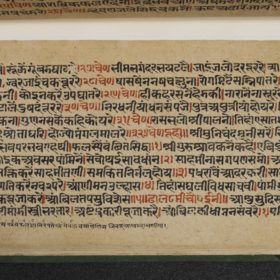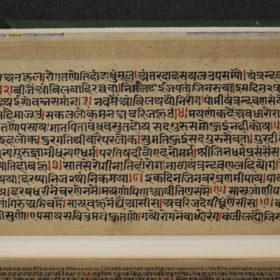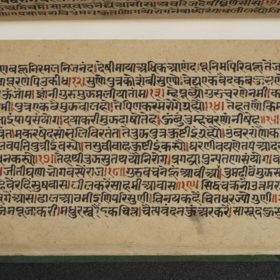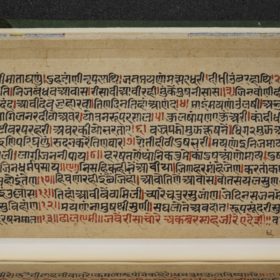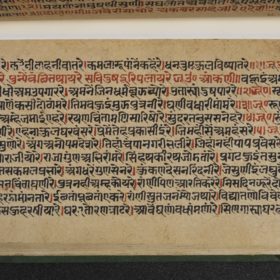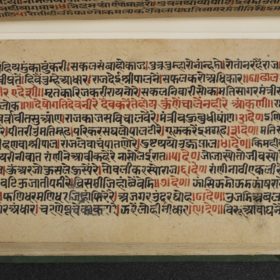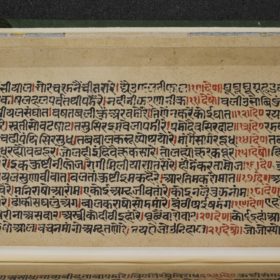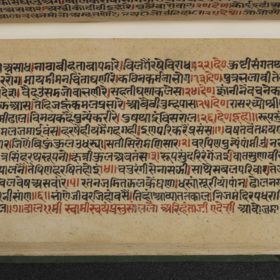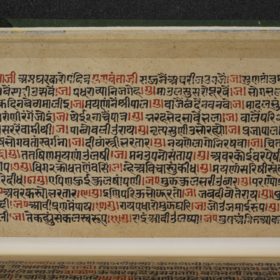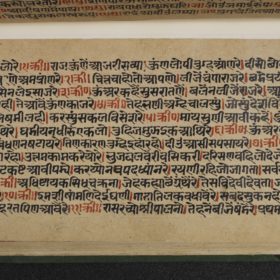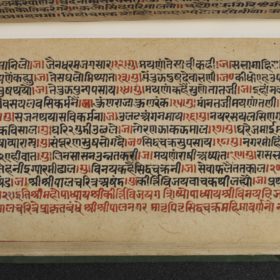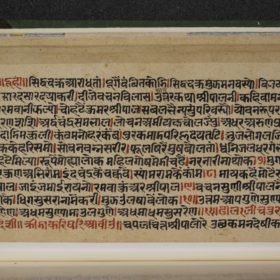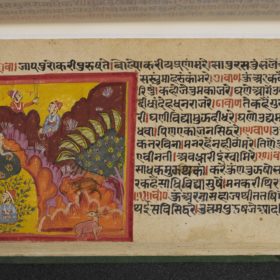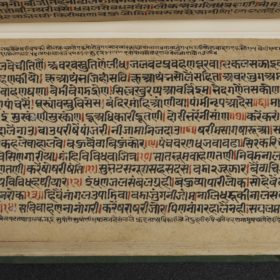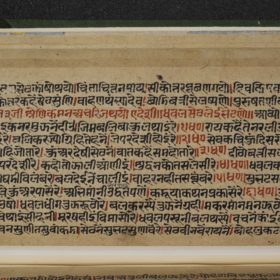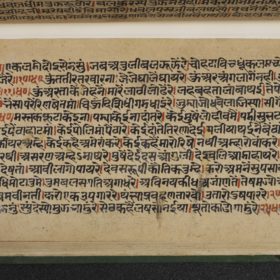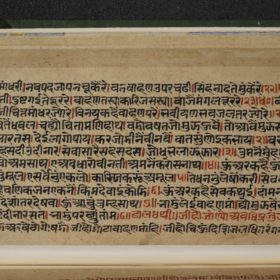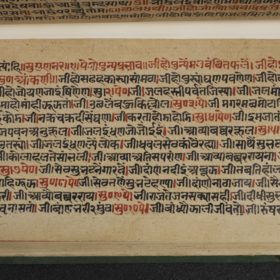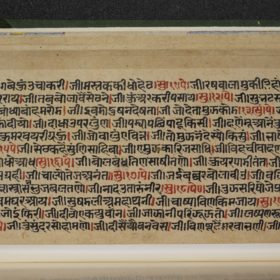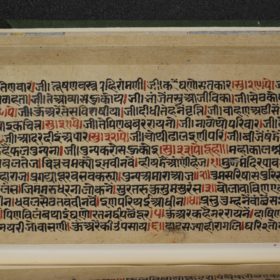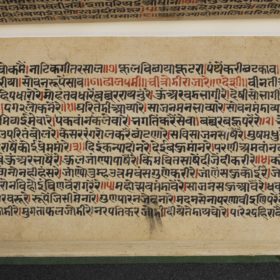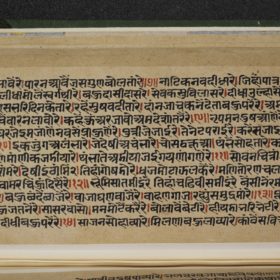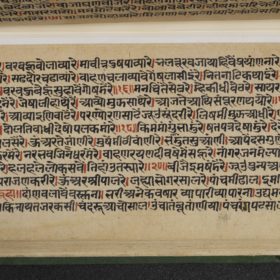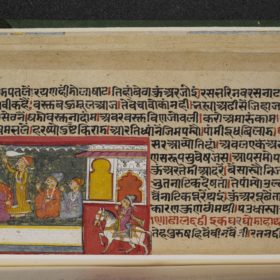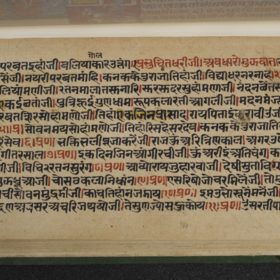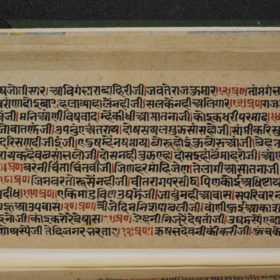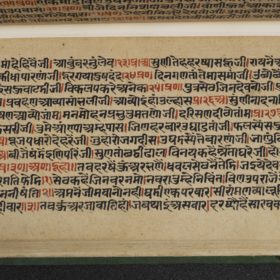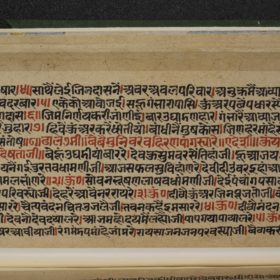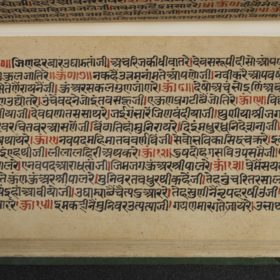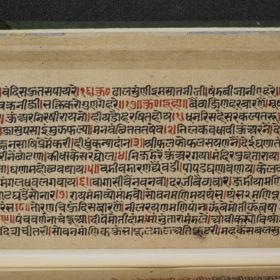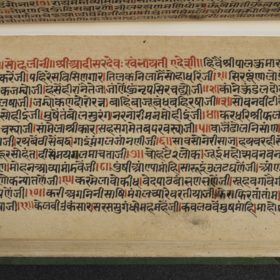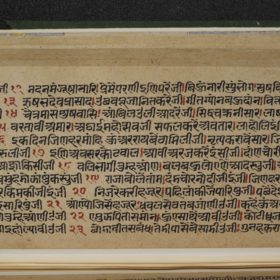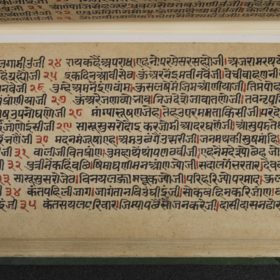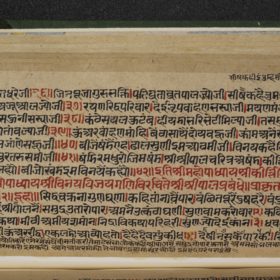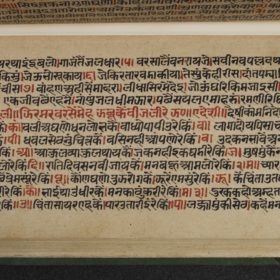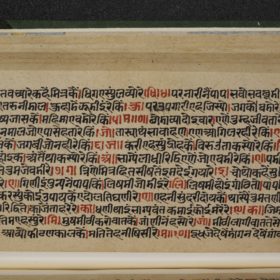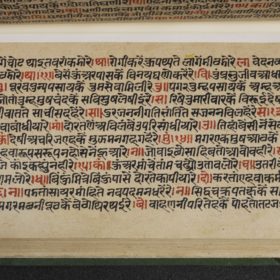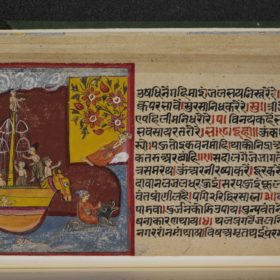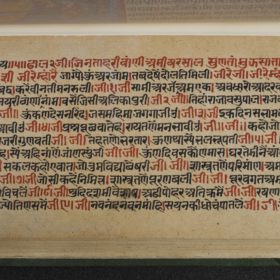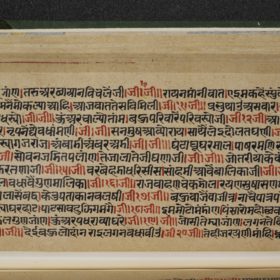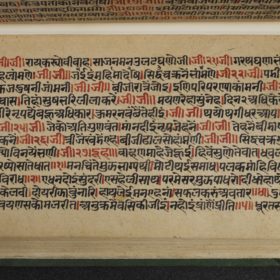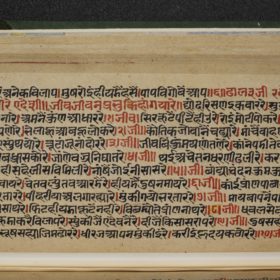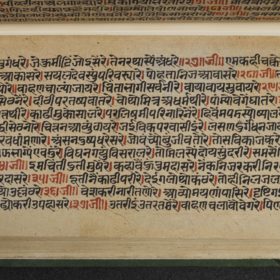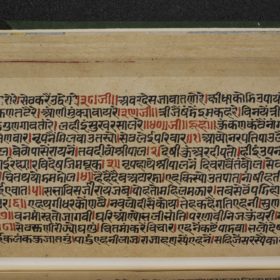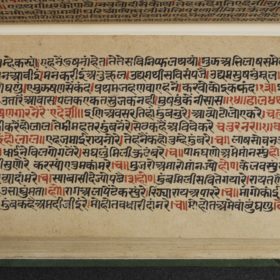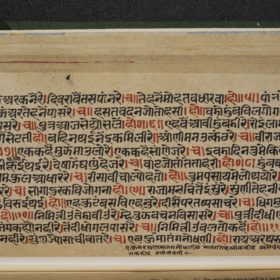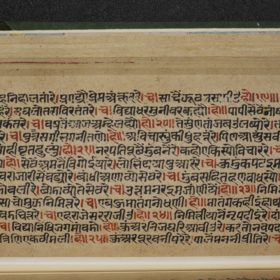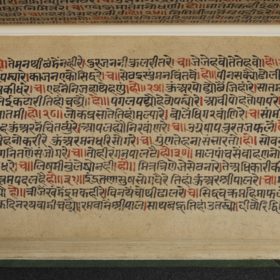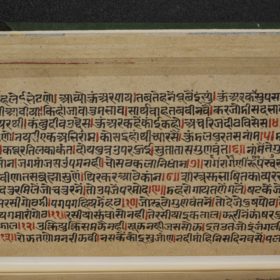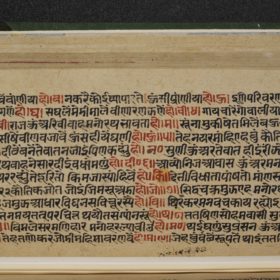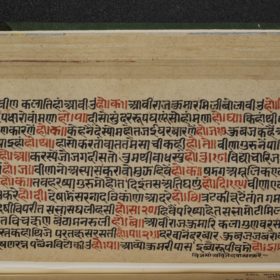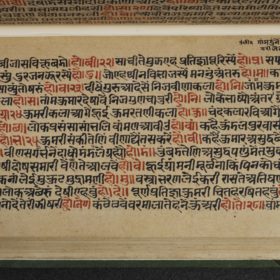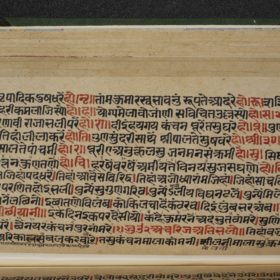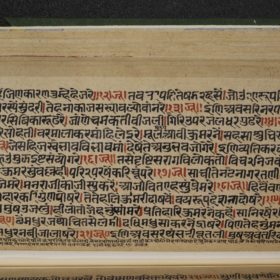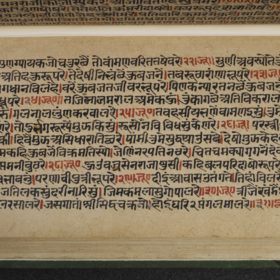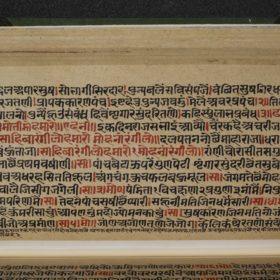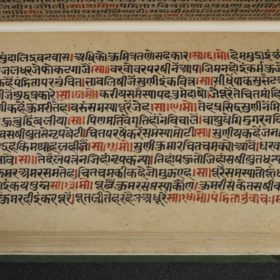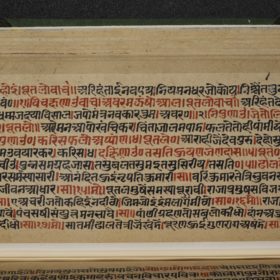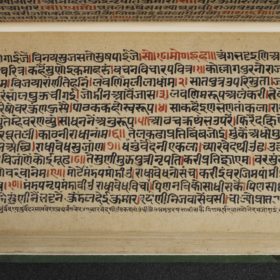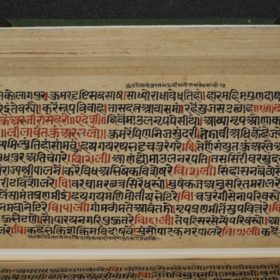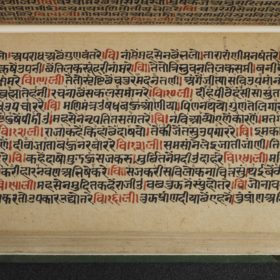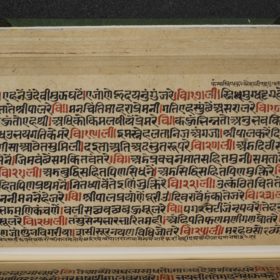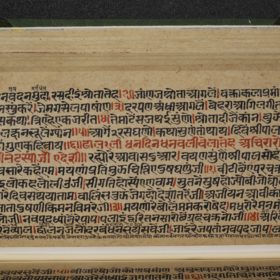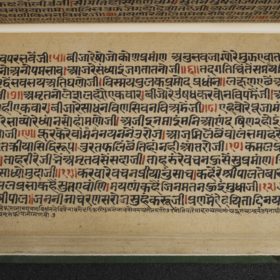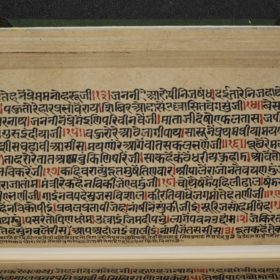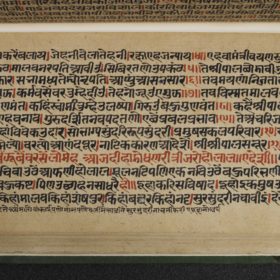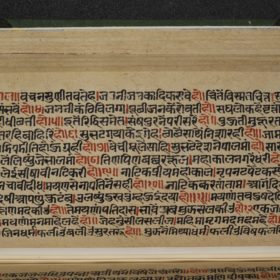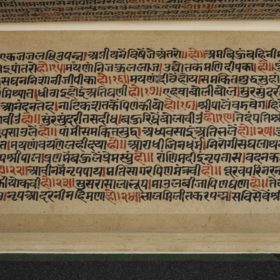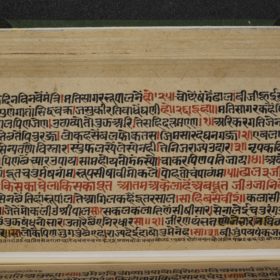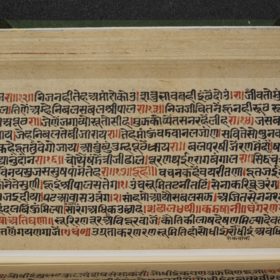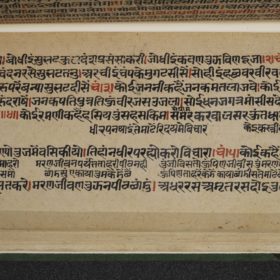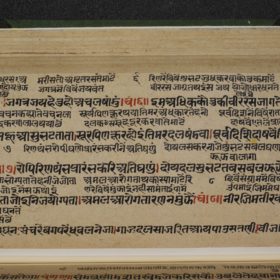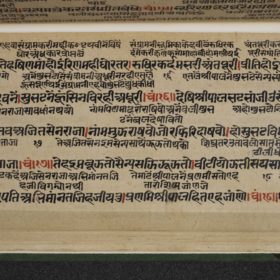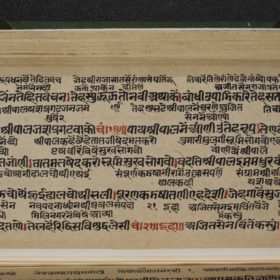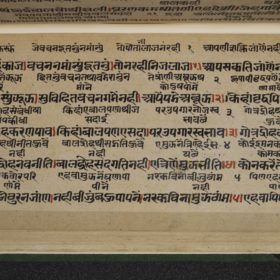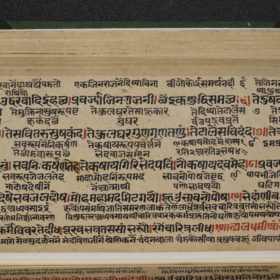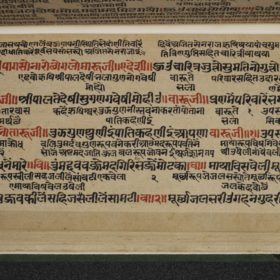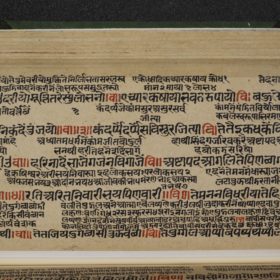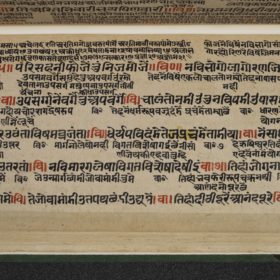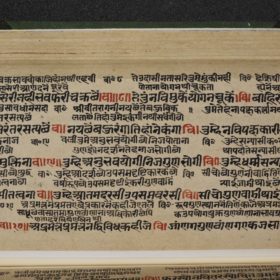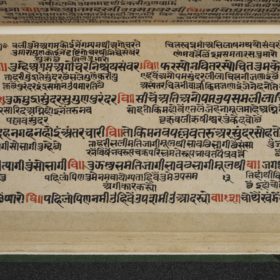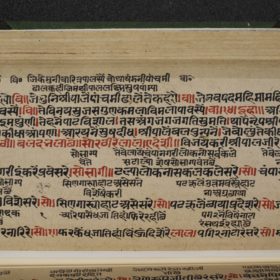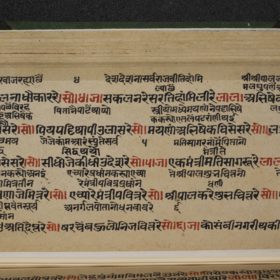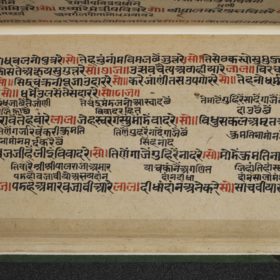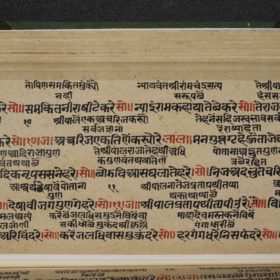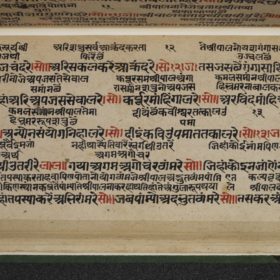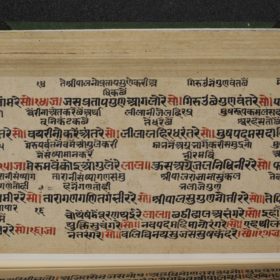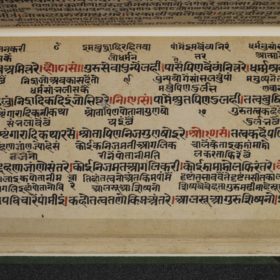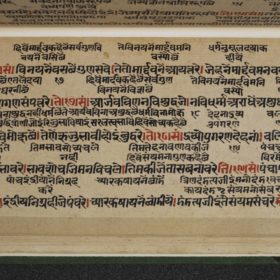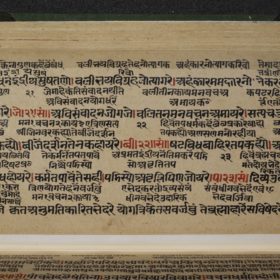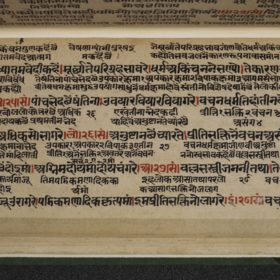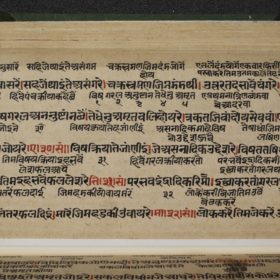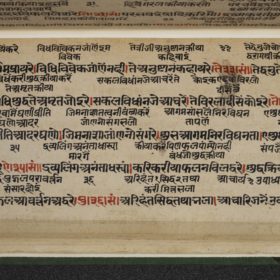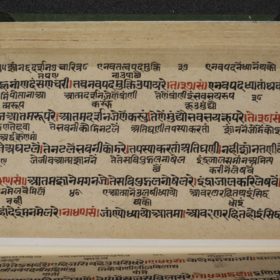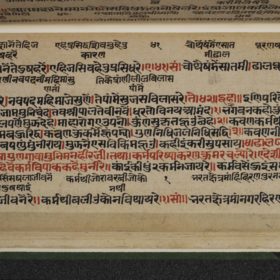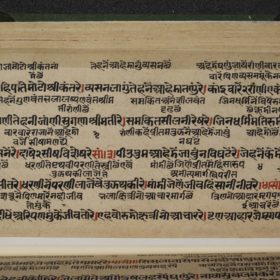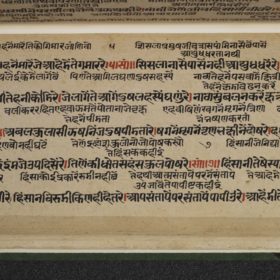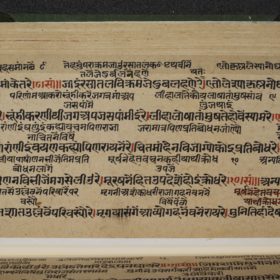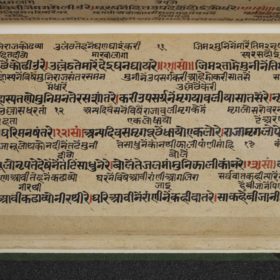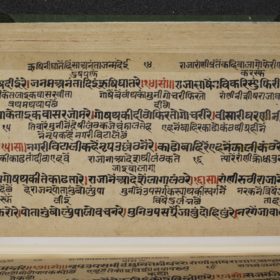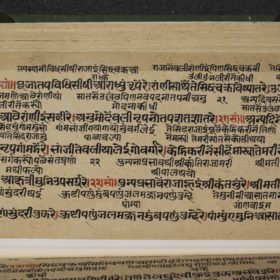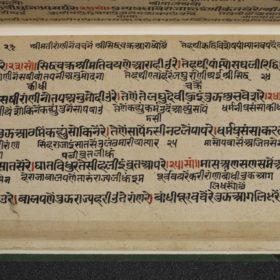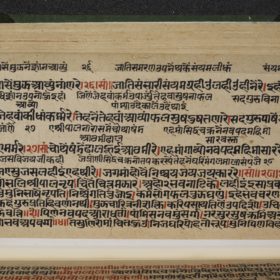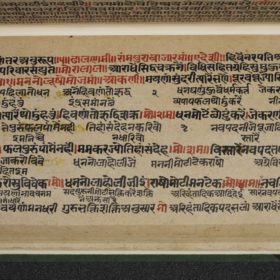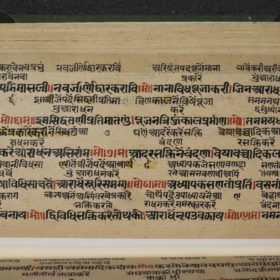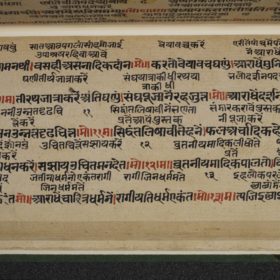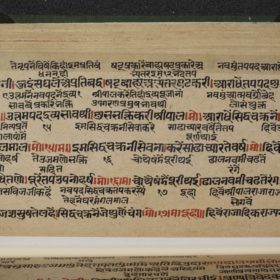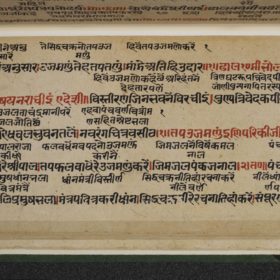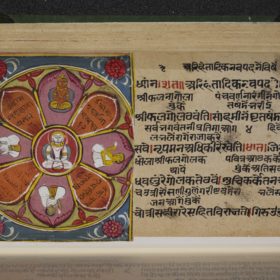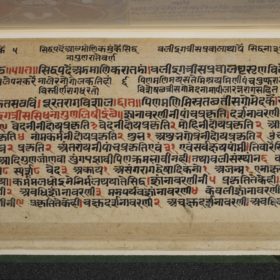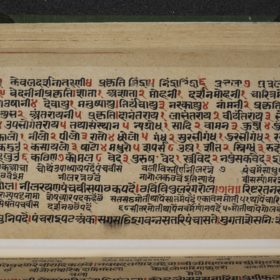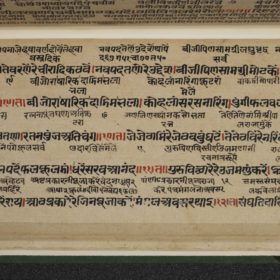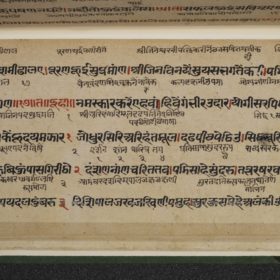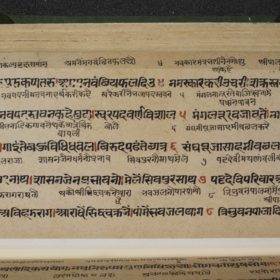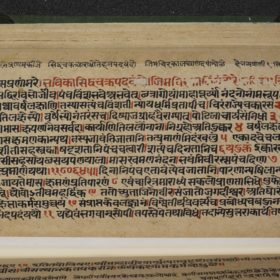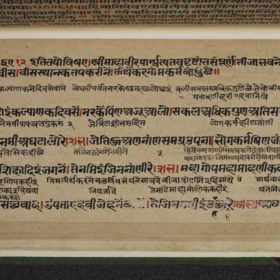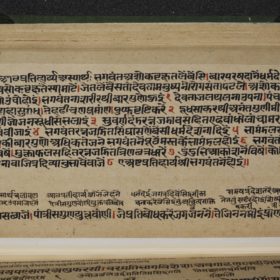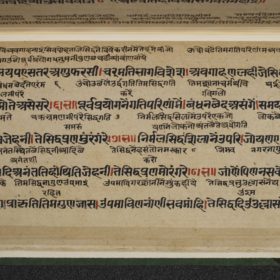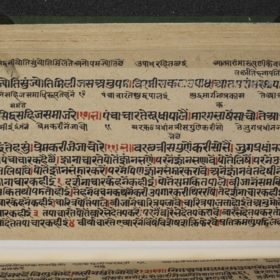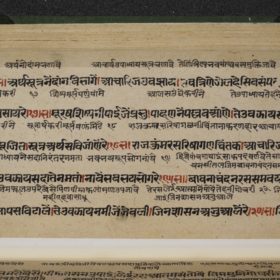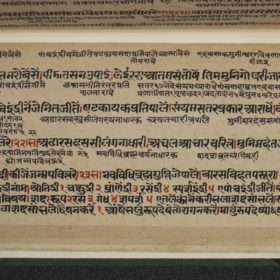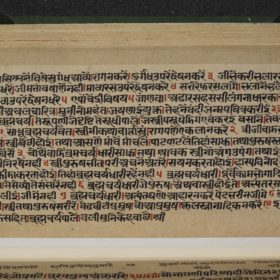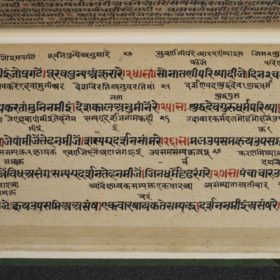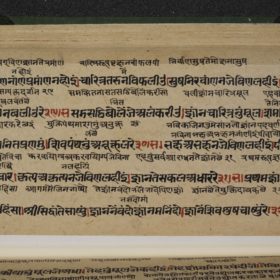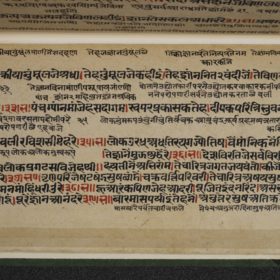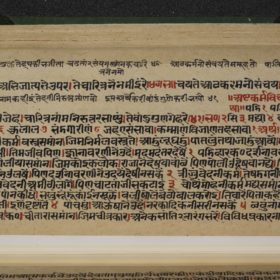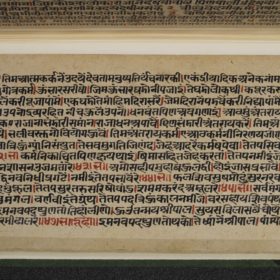
Background
This manuscript recounts the story of Śrīpāla, one of the favourite heroes of Jain story literature. Many authors have told the story of his life since at least the 14th century. Vinaya-vijaya’s version in Gujarati dates back to the 17th century and stands among the most popular ones.
Śrīpāla was a prince, but at the beginning of the story he appears as a leper. He becomes the husband of Princess Madanasundarī or Maynasundarī, after she has told her father, King Prajāpāla, that one’s fate depends on one’s own karma alone. After the marriage and devout prayer, Śrīpāla is cured of leprosy. The couple go through many adventures. Among the various people they meet is a Jain monk who teaches them the benefits of the navapada or siddhacakra.
Parts of the tale
There are eight main stages of the story.
The tale opens with King Prajāpāla of Ujjayinī, who has two daughters, Surasundarī and Mayanāsundarī, whose modern name is Mainasundarī. One day he questions them on what they think is the source of their happiness. Surasundarī answers that she owes everything to her father. Mayanasundarī thinks everything, good or bad, is the result of karma. Happy with the first daughter, the king asks her to choose her husband. Angry with the other one, he marries her to the prince of lepers. Mayanasundarī happily accepts her fate. It turns out that the prince of lepers is none other than Śrīpāla, a prince. After his marriage, he is cured of leprosy. Moreover, the couple have been told by a Jain ascetic about the navapada. Mayanasundarī's father repents.
In the next stage Śrīpāla is dejected after hearing that he is only thought of as King Prajāpāla's son-in-law. In order to demonstrate his own value, he leaves his happy life and the town of Ujjayinī.
His first significant encounter is with a sādhaka. Śrīpāla gives him help by using a vidyā his religious teacher had given him and receives in exchange two magical herbs. One enables him to cross water while the other will protect him against weapons.
The sādhaka leads him to some alchemists, whom Śrīpāla helps to produce gold. In exchange, they give him some, although he is reluctant to accept it.
Śrīpāla arrives at Broach, where the merchant Dhavala is looking for a young foreign man to sacrifice to the goddess, so that his ships can set sail. His men try to catch Śrīpāla but in vain. Śrīpāla meditates on the navapada and makes the ship move, then sails away with Dhavala.
Śrīpāla and Dhavala arrive in Babbarakula. King Mahākāla asks for a toll, which they refuse to pay. Mahākāla is defeated in the following fight, recognises Śrīpāla's superiority and offers his daughter, Madanasenā, in marriage.
They all go to Ratnadvīpa, where they meet Jinadāsa, son of the śrāvaka Jinadeva. He asks Śrīpāla to open the door of the sanctum of the Ṛṣabhanātha temple in Ratnasancaya. In spite of all the townspeople’s efforts, the door remains closed. Jinadāsa also asks him to marry Madanamanjūṣā, the king's daughter. The prince goes there, meditates upon the navapada, opens the door and gets Madanamanjūṣā as a third wife.
The prince now decides to go back home but has to face the jealousy of Dhavala, who decides to kill him. During the voyage he manages to throw Śrīpāla into the sea. Śrīpāla meditates upon the Nine Entities – depicted in the navapada or siddhacakra – and lands on an alligator's back. In the meantime, Dhavala thinks of other stratagems to get the two princesses for himself, but fails.
The distinction between a good man, Śrīpāla, and a wicked one, Dhavala, is clearly drawn.
The story of Śrīpāla is closely connected with the navapada or siddhacakra. This is a fundamental religious symbol associated with the doctrine of karma. This teaches that all human beings hold their destiny in their own hands.
Transcription
1. //§O// śrīPārśvanāthāya namaḥ //
2. atha Śrīpāla nī copaī likhyate
3. //dūhā// kalapa-veli-kaviyaṇa
4. taṇī / Sarasati kari supasāya / siddha-
5. cakra-guṇa-gāvatāṃ / pūri manoratha mā-
6. ya //1// aliya-vighana savi upasa-
7. meṃ / japatāṃ jina cauvīsa / namatāṃ ni-
8. ja guru-paya-kamala / jaga māṃ vadheṃ ja-
9. gīsa //2// guru Gautama Rājagṛhī ā-
10. vyā prabhu-ādesa / śvayaṃ mukha Śreṇika
11. pramukha neṃ / iṇi pari dyai upadesa //3// [u-
12. pagārī arihanta prabhu / siddhi-bhajo…
Translation
//§O// Homage to Lord Pārśva!
Now the poetical composition about Śrīpāla is being written.
Dūhā-stanza:
Sarasvatī, you who are the creeper granting all the poets’ desires, give me a good boon. Fulfil the desires of this humble me, as I am going to celebrate the qualities of the siddhacakra.
False things, obstacles – when uttering the names of the 24 Jinas, they all come to an end. When bowing to one’s own teacher the fame in this world increases.
Following the command of Lord [Mahāvīra], Gautama arrived in Rājagṛha. From his own mouth he gave as follows the teaching to Śreṇika and other people.
Glossary
Description
The caption on the top left says: Śrīpālarāsa-patra 1 – 'The poetic composition on Śrīpāla, folio 1'.
There are two illustrated panels on the page, both underlining the religious and artistic importance of this text.
Left-hand panel
The left-hand image is a visualisation of the double homage paid by the author at the opening of his work to the Jina Pārśvanātha or Lord Pārśva and to Sarasvatī, the goddess of letters, poetic creation and, more generally, the arts.
A temple enshrines an image of a Jina. The temple evokes the style of the Western Indian temples in its structure and the banner. The idol is fanned by two worshippers who hold cāmaras in their hands. The Jina is seated in the traditional lotus posture of meditation. The snake-hoods that are commonly seen in images of Pārśva are not very clear here so the Jina image appears rather uncharacterised.
At the bottom Sarasvatī is shown holding the vīṇā in her hand and mounted on her vehicle, the white swan. Folding hands in front of her is a Śvetāmbara Jain monk, identified by his white robe and the staff. He is Vinayavijaya, the author of the work.
Right-hand panel
The right-hand image is a teaching scene. Seated under the shade of a tree is Indrabhūti Gautama, the leading disciple of Mahāvīra, the 24th Jina. He is a Jain monk, identified by his white robe and the broom under one of his arms. In one of his hands he holds what could be a scroll or book. His second hand demonstrates the typical teaching gesture.
Sitting in front of him are the larger figure of King Śreṇika with his retinue of men, one of them holding a fly-whisk. The women are respectfully seated at the side of the monk, not in front of him.
Where the teacher is becomes a sacred place, similar to an ashram, where vehicles and forms of transport are out of place. This is why they are at the border of the picture.
Other visual elements
There are several notable things about this page, namely:
- the red sign inside red vertical lines at the beginning is an auspicious symbol known as bhale, often used at the start of a manuscript
- it is common to emphasise the beginning of a text by writing in red ink instead of the usual black, like here
- at the bottom right is the number 1, which is the folio number.
At the bottom of the left-hand margin is the phrase potā nai mukhai śrīmukha – 'from his own mouth, from his glorious mouth'. This is an expansion of the words svayaṃ mukha – 'from his own mouth' – on line 10. The sign resembling = above the word svayaṃ draws attention to the gloss in the margin.
At the top of the right-hand margin is the phrase vidyārupa veli kavi svara nī – 'the creeper in the form of knowledge for the voice of poets'. This is an explanation of the words kalapaveli kaviyaṇa taṇī found on lines 3 to 4. At the end of line 3 the sign resembling = above the word yadraws attention to the gloss in the margin.
Note that verse numbers are at the end of each stanza and are often written between two vertical lines, like here. On this page are the following numbers:
- 1 at the beginning of line 6
- 2 at the beginning of line 9
- 3 at the end of line 11.
Script
The script is the Jaina Devanāgarī script. It is used for writing numerous Indian languages, here for Gujarati.
Note the red vertical lines within the text. Though they are used to divide the long sentences into smaller parts, they are not necessarily punctuation marks.
- Source:
The British Library Board
- Shelfmark:
Or. 13622
- Author:
Vinayavijaya and Yaśovijaya
- Date of creation:
17th to 18th centuries
- Folio number:
1 verso
- Total number of folios:
88
- Place of creation:
western India
- Language:
Gujarati
- Medium:
watercolour on paper
- Size:
24 x 11 cms
- Copyright:
CC0 1.0 (Creative Commons Public Domain)
- Image Copyright:
Description
The caption on the top left says: Śrīpālarāsa-patra 1 – ‘The poetic composition on Śrīpāla, folio 1’.
There are two illustrated panels on the page, both underlining the religious and artistic importance of this text.
Left-hand panel
The left-hand image is a visualisation of the double homage paid by the author at the opening of his work to the Jina Pārśvanātha or Lord Pārśva and to Sarasvatī, the goddess of letters, poetic creation and, more generally, the arts.
A temple enshrines an image of a Jina. The temple evokes the style of the Western Indian temples in its structure and the banner. The idol is fanned by two worshippers who hold cāmaras in their hands. The Jina is seated in the traditional lotus posture of meditation. The snake-hoods that are commonly seen in images of Pārśva are not very clear here so the Jina image appears rather uncharacterised.
At the bottom Sarasvatī is shown holding the vīṇā in her hand and mounted on her vehicle, the white swan. Folding hands in front of her is a Śvetāmbara Jain monk, identified by his white robe and the staff. He is Vinayavijaya, the author of the work.
Right-hand panel
The right-hand image is a teaching scene. Seated under the shade of a tree is Indrabhūti Gautama, the leading disciple of Mahāvīra, the 24th Jina. He is a Jain monk, identified by his white robe and the broom under one of his arms. In one of his hands he holds what could be a scroll or book. His second hand demonstrates the typical teaching gesture.
Sitting in front of him are the larger figure of King Śreṇika with his retinue of men, one of them holding a fly-whisk. The women are respectfully seated at the side of the monk, not in front of him.
Where the teacher is becomes a sacred place, similar to an ashram, where vehicles and forms of transport are out of place. This is why they are at the border of the picture.
Other visual elements
There are several notable things about this page, namely:
- the red sign inside red vertical lines at the beginning is an auspicious symbol known as bhale, often used at the start of a manuscript
- it is common to emphasise the beginning of a text by writing in red ink instead of the usual black, like here
- at the bottom right is the number 1, which is the folio number.
At the bottom of the left-hand margin is the phrase potā nai mukhai śrīmukha – ‘from his own mouth, from his glorious mouth’. This is an expansion of the words svayaṃ mukha – ‘from his own mouth’ – on line 10. The sign resembling = above the word svayaṃ draws attention to the gloss in the margin.
At the top of the right-hand margin is the phrase vidyārupa veli kavi svara nī – ‘the creeper in the form of knowledge for the voice of poets’. This is an explanation of the words kalapaveli kaviyaṇa taṇī found on lines 3 to 4. At the end of line 3 the sign resembling = above the word yadraws attention to the gloss in the margin.
Note that verse numbers are at the end of each stanza and are often written between two vertical lines, like here. On this page are the following numbers:
- 1 at the beginning of line 6
- 2 at the beginning of line 9
- 3 at the end of line 11.
Script
The script is the Jaina Devanāgarī script. It is used for writing numerous Indian languages, here for Gujarati.
Note the red vertical lines within the text. Though they are used to divide the long sentences into smaller parts, they are not necessarily punctuation marks.





























































































